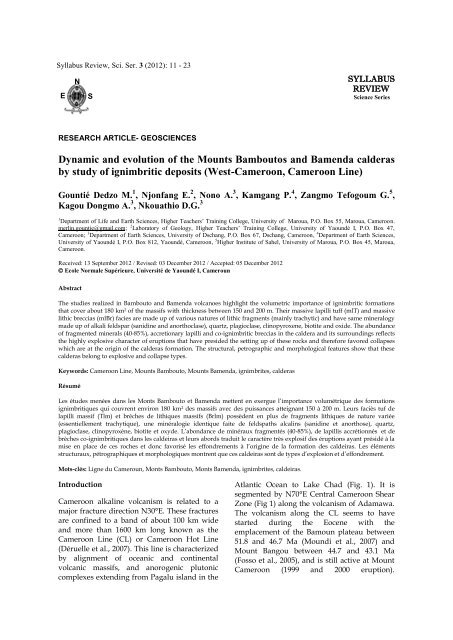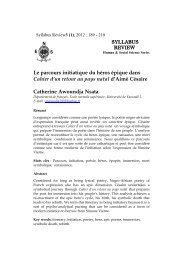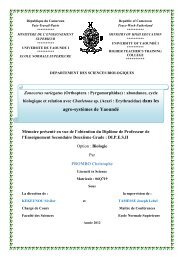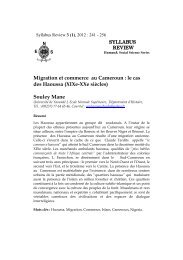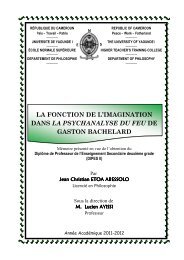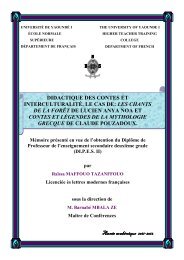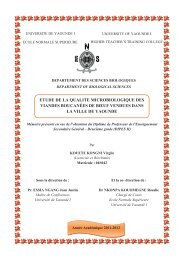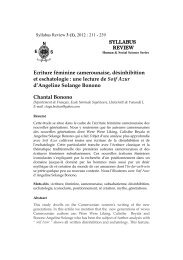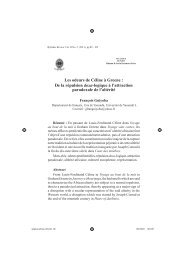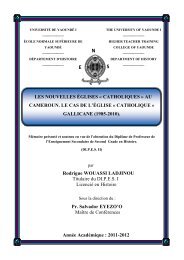Dynamic and evolution of the Mounts Bamboutos and ... - L'ENS
Dynamic and evolution of the Mounts Bamboutos and ... - L'ENS
Dynamic and evolution of the Mounts Bamboutos and ... - L'ENS
You also want an ePaper? Increase the reach of your titles
YUMPU automatically turns print PDFs into web optimized ePapers that Google loves.
Syllabus Review, Sci. Ser. 3 (2012): 11 - 23<br />
E<br />
N<br />
RESEARCH ARTICLE- GEOSCIENCES<br />
SYLLABUS<br />
REVIEW<br />
Science Series<br />
<strong>Dynamic</strong> <strong>and</strong> <strong>evolution</strong> <strong>of</strong> <strong>the</strong> <strong>Mounts</strong> <strong>Bamboutos</strong> <strong>and</strong> Bamenda calderas<br />
by study <strong>of</strong> ignimbritic deposits (West-Cameroon, Cameroon Line)<br />
Gountié Dedzo M. 1 , Njonfang E. 2 , Nono A. 3 , Kamgang P. 4 , Zangmo Tefogoum G. 5 ,<br />
Kagou Dongmo A. 3 , Nkouathio D.G. 3<br />
1 Department <strong>of</strong> Life <strong>and</strong> Earth Sciences, Higher Teachers’ Training College, University <strong>of</strong> Maroua, P.O. Box 55, Maroua, Cameroon.<br />
merlin.gountie@gmail.com; 2 Laboratory <strong>of</strong> Geology, Higher Teachers’ Training College, University <strong>of</strong> Yaoundé I, P.O. Box 47,<br />
Cameroon; 3 Department <strong>of</strong> Earth Sciences, University <strong>of</strong> Dschang, P.O. Box 67, Dschang, Cameroon, 4 Department <strong>of</strong> Earth Sciences,<br />
University <strong>of</strong> Yaoundé I, P.O. Box 812, Yaoundé, Cameroon, 5 Higher Institute <strong>of</strong> Sahel, University <strong>of</strong> Maroua, P.O. Box 45, Maroua,<br />
Cameroon.<br />
Received: 13 September 2012 / Revised: 03 December 2012 / Accepted: 05 December 2012<br />
Ecole Normale Supérieure, Université de Yaoundé I, Cameroun<br />
Abstract<br />
The studies realized in Bambouto <strong>and</strong> Bamenda volcanoes highlight <strong>the</strong> volumetric importance <strong>of</strong> ignimbritic formations<br />
that cover about 180 km 2 <strong>of</strong> <strong>the</strong> massifs with thickness between 150 <strong>and</strong> 200 m. Their massive lapilli tuff (mlT) <strong>and</strong> massive<br />
lithic breccias (mlBr) facies are made up <strong>of</strong> various natures <strong>of</strong> lithic fragments (mainly trachytic) <strong>and</strong> have same mineralogy<br />
made up <strong>of</strong> alkali feldspar (sanidine <strong>and</strong> anorthoclase), quartz, plagioclase, clinopyroxene, biotite <strong>and</strong> oxide. The abundance<br />
<strong>of</strong> fragmented minerals (40-85%), accretionary lapilli <strong>and</strong> co-ignimbritic breccias in <strong>the</strong> caldera <strong>and</strong> its surroundings reflects<br />
<strong>the</strong> highly explosive character <strong>of</strong> eruptions that have presided <strong>the</strong> setting up <strong>of</strong> <strong>the</strong>se rocks <strong>and</strong> <strong>the</strong>refore favored collapses<br />
which are at <strong>the</strong> origin <strong>of</strong> <strong>the</strong> calderas formation. The structural, petrographic <strong>and</strong> morphological features show that <strong>the</strong>se<br />
calderas belong to explosive <strong>and</strong> collapse types.<br />
Keywords: Cameroon Line, <strong>Mounts</strong> Bambouto, <strong>Mounts</strong> Bamenda, ignimbrites, calderas<br />
Résumé<br />
S<br />
Les études menées dans les Monts Bambouto et Bamenda mettent en exergue l’importance volumétrique des formations<br />
ignimbritiques qui couvrent environ 180 km 2 des massifs avec des puissances atteignant 150 à 200 m. Leurs faciès tuf de<br />
lapilli massif (Tlm) et brèches de lithiques massifs (Brlm) possèdent en plus de fragments lithiques de nature variée<br />
(essentiellement trachytique), une minéralogie identique faite de feldspaths alcalins (sanidine et anorthose), quartz,<br />
plagioclase, clinopyroxène, biotite et oxyde. L’abondance de minéraux fragmentés (40-85%), de lapillis accrétionnés et de<br />
brèches co-ignimbritiques dans les caldeiras et leurs abords traduit le caractère très explosif des éruptions ayant présidé à la<br />
mise en place de ces roches et donc favorisé les effondrements à l’origine de la formation des caldeiras. Les éléments<br />
structuraux, pétrographiques et morphologiques montrent que ces caldeiras sont de types d’explosion et d’effondrement.<br />
Mots-clés: Ligne du Cameroun, Monts Bambouto, Monts Bamenda, ignimbrites, caldeiras.<br />
Introduction<br />
Cameroon alkaline volcanism is related to a<br />
major fracture direction N30°E. These fractures<br />
are confined to a b<strong>and</strong> <strong>of</strong> about 100 km wide<br />
<strong>and</strong> more than 1600 km long known as <strong>the</strong><br />
Cameroon Line (CL) or Cameroon Hot Line<br />
(Déruelle et al., 2007). This line is characterized<br />
by alignment <strong>of</strong> oceanic <strong>and</strong> continental<br />
volcanic massifs, <strong>and</strong> anorogenic plutonic<br />
complexes extending from Pagalu isl<strong>and</strong> in <strong>the</strong><br />
Atlantic Ocean to Lake Chad (Fig. 1). It is<br />
segmented by N70°E Central Cameroon Shear<br />
Zone (Fig 1) along <strong>the</strong> volcanism <strong>of</strong> Adamawa.<br />
The volcanism along <strong>the</strong> CL seems to have<br />
started during <strong>the</strong> Eocene with <strong>the</strong><br />
emplacement <strong>of</strong> <strong>the</strong> Bamoun plateau between<br />
51.8 <strong>and</strong> 46.7 Ma (Moundi et al., 2007) <strong>and</strong><br />
Mount Bangou between 44.7 <strong>and</strong> 43.1 Ma<br />
(Fosso et al., 2005), <strong>and</strong> is still active at Mount<br />
Cameroon (1999 <strong>and</strong> 2000 eruption).
Gountié Dedzo et al. / Syllabus Review, Sci. Ser. 3, 2012 : 11 - 23<br />
Fig. 1. a) Location map <strong>of</strong> <strong>the</strong> Cameroon Volcanic Line (CVL). b) The CL (diagonal grey area) with <strong>the</strong> main volcanic<br />
centres <strong>and</strong> <strong>the</strong> plutonic complexes (In Nkouathio et al., 2008). Central Cameroon Shear Zone according to Ngako et<br />
al. (2006); Fracture zones following Lee et al. (1994) <strong>and</strong> Ballentine et al. (1997).<br />
The products <strong>of</strong> this volcanism are mainly<br />
basalt, trachyte, phonolite <strong>and</strong> rhyolites;<br />
ignimbritic deposits are found only in <strong>the</strong><br />
continental part <strong>of</strong> <strong>the</strong> CL, particularly in <strong>the</strong><br />
<strong>Mounts</strong> Bambouto <strong>and</strong> Bamenda. O<strong>the</strong>r small<br />
deposits (< 10 km 2 ) are also reported in<br />
Nkogam massif (Kamgang, 1986), <strong>and</strong> in<br />
Mount Oku (Dunlop, 1983 <strong>and</strong> Lissom, 1991).<br />
The purpose <strong>of</strong> this work is to constrain <strong>the</strong><br />
ignimbritic deposits <strong>of</strong> <strong>the</strong> <strong>Mounts</strong> Bambouto<br />
<strong>and</strong> Bamenda in relation with <strong>the</strong> caldera<br />
genesis.<br />
Geological setting<br />
<strong>Mounts</strong> Bambouto <strong>and</strong> Bamenda belong to <strong>the</strong><br />
most important geomorphologic system in <strong>the</strong><br />
region called West-Cameroon Highl<strong>and</strong>s<br />
(Morin, 1988).<br />
12
Gountié Dedzo et al. / Syllabus Review, Sci. Ser. 3, 2012 : 11 - 23<br />
<strong>Mounts</strong> Bambouto<br />
<strong>Mounts</strong> Bambouto are <strong>the</strong> third largest volcano<br />
(800 km 2 ) <strong>of</strong> <strong>the</strong> CL after <strong>Mounts</strong> Cameroon<br />
<strong>and</strong> Manengouba. This massif is situated<br />
between longitudes 09°57'E <strong>and</strong> 10°15'E <strong>and</strong><br />
latitudes 05 °27'N <strong>and</strong> 05 °48'N. Mount Mélétan<br />
(2740 m) is <strong>the</strong> highest point <strong>of</strong> <strong>the</strong> massif.<br />
Volcanic products <strong>of</strong> <strong>the</strong> massif are made up <strong>of</strong><br />
basalts, trachytes, phonolites, rhyolites <strong>and</strong><br />
ignimbrites. Their ages ranged from 21.12 Ma<br />
to 0.50 Ma (Gouhier et al. 1974; Tchoua, 1974 ;<br />
Dunlop, 1983; Fitton <strong>and</strong> Dunlop, 1985;<br />
Marzoli et al. 1999; 2000; Youmen et al., 2005 ;<br />
Nkouathio et al. 2008; 10, Kagou Dongmo et al.,<br />
2010).<br />
The lower part <strong>of</strong> Bambouto massif is<br />
composed <strong>of</strong> basaltic rocks that cover in places<br />
thick ignimbritic flow deposits with various<br />
facies (Gountié Dedzo, 2002, 2004; Nono et al.,<br />
2003, 2004; Gountié Dedzo et al., 2011a). In <strong>the</strong><br />
upper <strong>and</strong> middle parts, felsic rocks (trachyte,<br />
phonolite, rhyolite <strong>and</strong> ignimbrite)<br />
predominate <strong>and</strong> represent 60-65% <strong>of</strong> <strong>the</strong><br />
massif. The Miocene ignimbrites (12.7 to 18.1<br />
Ma) (Gouhier et al. 1974; Tchoua, 1974; Marzoli<br />
et al. 1999; Youmen et al., 2005) that lie on<br />
granitic basement have been considered as <strong>the</strong><br />
first products <strong>of</strong> volcanic activity <strong>of</strong> <strong>the</strong> massif<br />
(Tchoua, 1973). The discovery <strong>of</strong> enclaves <strong>of</strong><br />
basaltic scoriae in some <strong>of</strong> <strong>the</strong>se ignimbritic<br />
formations lying on basement rock helped<br />
highlight an early volcanic stage which is<br />
strombolian <strong>and</strong> pre-ignimbritic in <strong>the</strong> south <strong>of</strong><br />
<strong>the</strong> massif (Nono et al., 2004).<br />
A syn<strong>the</strong>tic revision <strong>of</strong> <strong>the</strong> volcanic story <strong>of</strong><br />
Mount Bambouto is proposed as follows by<br />
Kagou et al. (2010) <strong>and</strong> Zangmo Tefogoum et<br />
al. (2011). The first stage (precaldera stage), ca.<br />
21 Ma, corresponds to <strong>the</strong> building <strong>of</strong> <strong>the</strong> initial<br />
basaltic shield volcano <strong>and</strong> characterized by<br />
<strong>the</strong> tumescence <strong>of</strong> <strong>the</strong> volcanic shield due to<br />
magma injection giving rise to several annular<br />
fissures observed in <strong>the</strong> whole volcano. The<br />
second stage (syncaldera stage), from 18.5 to<br />
15.3 Ma, is marked by <strong>the</strong> collapse <strong>of</strong> <strong>the</strong><br />
caldera linked to <strong>the</strong> pouring out <strong>of</strong> ignimbritic<br />
rhyolites <strong>and</strong> trachytes. Zangmo Tefogoum<br />
(2007) has shown that <strong>the</strong> model <strong>of</strong> formation<br />
<strong>of</strong> this caldera is comparable to that <strong>of</strong> Cole et<br />
al. (2005). The third stage (postcaldera stage),<br />
from 15 to 4.5 Ma, renews with basaltic effusive<br />
activity, toge<strong>the</strong>r with post-caldera extrusions<br />
<strong>of</strong> trachytes <strong>and</strong> phonolites. The 0.5 Ma Totap<br />
basaltic effusive activity could indicate <strong>the</strong><br />
beginning <strong>of</strong> a fourth phase.<br />
<strong>Mounts</strong> Bamenda<br />
<strong>Mounts</strong> Bamenda (600 km 2 ), which constitute<br />
in volumetric importance <strong>the</strong> fourth largest<br />
volcano <strong>of</strong> <strong>the</strong> CL, are <strong>the</strong> NE extension <strong>of</strong> <strong>the</strong><br />
<strong>Mounts</strong> Bambouto with which <strong>the</strong>y do not<br />
have clear limit. This massif lies between<br />
longitudes 10°00'E <strong>and</strong> 10°30'E <strong>and</strong> latitudes<br />
05°45'N <strong>and</strong> 06°10'N <strong>and</strong> culminates at 2621 m<br />
at Lake Bambili. Petrographic <strong>and</strong> geochemical<br />
studies (Kamgang et al. 2007; 2008; 2010) show<br />
that <strong>the</strong> <strong>Mounts</strong> Bamenda consist <strong>of</strong> basanites,<br />
basalts, hawaiites, mugearites, benmoreites,<br />
trachytes, rhyolites <strong>and</strong> ignimbrites. <strong>the</strong>se<br />
rhyolitic ignimbrite overlays basement rock<br />
(constituted by granite <strong>and</strong> gneiss) <strong>and</strong> are<br />
covered by laterized basalt. The felsic lavas are<br />
most abundant than intermediate types<br />
(mugearites <strong>and</strong> benmoreites). The radiometric<br />
dating gives ages ranging from <strong>the</strong> current to<br />
17.4 Ma for <strong>the</strong> basaltic lavas <strong>and</strong> from 18.98<br />
Ma to 27.40 Ma for <strong>the</strong> felsic lavas (Kamgang et<br />
al., 2007, 2008).<br />
<strong>Mounts</strong> Bambouto <strong>and</strong> Bamenda calderas<br />
The <strong>Mounts</strong> Bambouto caldera (Fig. 2 <strong>and</strong> 3a)<br />
is located in <strong>the</strong> uppermost zone <strong>of</strong> <strong>the</strong> massif<br />
<strong>and</strong> is an asymmetrical depression with a<br />
roughly elliptical shape <strong>of</strong> about 13 km from<br />
West to East <strong>and</strong> 8 km from North to South. It<br />
has on its sou<strong>the</strong>ast side, subvertical walls (Fig.<br />
4a) rising up to 1300 m above its floor bristling<br />
with trachytic <strong>and</strong> phonolitic domes <strong>and</strong> flowdomes.<br />
These walls are lowered from East to<br />
West until it disappears at <strong>the</strong> opening <strong>of</strong> <strong>the</strong><br />
caldera.<br />
The <strong>Mounts</strong> Bamenda are characterized by <strong>the</strong><br />
presence <strong>of</strong> two calderas (Fig. 2 <strong>and</strong> 3b) <strong>of</strong><br />
smaller dimensions: <strong>the</strong> calderas <strong>of</strong> Santa-Mbu<br />
(6 x 4 km) <strong>and</strong> Lefo (4 x 3 km). Their floor<br />
located respectively at elevation <strong>of</strong> 550 m <strong>and</strong><br />
400 m is mainly composed <strong>of</strong> trachytic domes,<br />
which are also abundant on <strong>the</strong> external slopes<br />
<strong>of</strong> <strong>the</strong> massif (Fig. 4b).<br />
The calderas <strong>of</strong> <strong>the</strong>se volcanic massifs are<br />
covered by felsic rocks; such as trachyte,<br />
ignimbrite, phonolite <strong>and</strong> rhyolite. These rocks<br />
uneven <strong>the</strong> calderas morphology; <strong>the</strong>y are<br />
found in prismatic lavas on <strong>the</strong> caldera rims<br />
<strong>and</strong> in <strong>the</strong> protrusions on <strong>the</strong> caldera floor (Fig.<br />
5). Therefore, <strong>the</strong> slopes are very diverse in<br />
several directions; <strong>the</strong> “V” shaped valleys are<br />
found in <strong>the</strong> different directions <strong>of</strong> <strong>the</strong><br />
calderas.<br />
13
Gountié Dedzo et al. / Syllabus Review, Sci. Ser. 3, 2012 : 11 - 23<br />
Fig. 2. Digital elevation model (DEM) <strong>of</strong> <strong>Mounts</strong> Bambouto<br />
<strong>and</strong> Bamenda showing <strong>the</strong> different calderas (Shuttle<br />
Radar Topography Mission; SRTM, NASA).<br />
Fig. 3. Geologic sketch maps <strong>of</strong> <strong>Mounts</strong> Bambouto (a) <strong>and</strong><br />
Bamenda (modified after Kamgang et al., 2010) (b).<br />
Fig. 4. a) SE border <strong>of</strong> <strong>Mounts</strong> Bambouto caldera. b) NE<br />
border <strong>of</strong> Lefo caldera constituted by subvertical prismatic<br />
trachyte<br />
Methodology <strong>and</strong> analytical methods<br />
The methodology <strong>of</strong> this work is essentially<br />
based on field observations, thin sections<br />
studies <strong>and</strong> bibliographic review. Nature <strong>of</strong><br />
feldspars, <strong>the</strong> most dominant mineral phase,<br />
was investigated in GET (Géosciences<br />
Environnement Toulouse) laboratory by<br />
electron microprobe analyses on CAMECA<br />
SX50 apparatus operating at <strong>the</strong> usual<br />
conditions. The ages are from Youmen et al.<br />
(2005) (Ar/Ar method), Kamgang et al. (2007)<br />
(K/Ar method) <strong>and</strong> Fitton <strong>and</strong> Dunlop (1985)<br />
(K/Ar method).<br />
Fig. 5: a) <strong>and</strong> b) Geological cross-sections <strong>of</strong> <strong>the</strong> <strong>Mounts</strong><br />
Bambouto caldera (modified after Zangmo et al., 2011); c)<br />
Geological cross-section <strong>of</strong> <strong>the</strong> sou<strong>the</strong>rn slope <strong>of</strong> <strong>Mounts</strong><br />
Bambouto with a part <strong>of</strong> caldera; d) <strong>and</strong> e) Geological<br />
cross-sections <strong>of</strong> <strong>the</strong> <strong>Mounts</strong> Bamenda calderas (modified<br />
after Zangmo et al., 2011)<br />
Field observations <strong>and</strong> petrography<br />
The ignimbrites <strong>of</strong> <strong>Mounts</strong> Bambouto<br />
The ignimbrites outcrop discontinuously on<br />
about 17% <strong>of</strong> <strong>the</strong> massif (Fig. 3a) representing<br />
approximately 135 km 2 for a total volume<br />
estimated at 13.5 km 3 . This volume is really<br />
much important (> 20 km 3 ) because <strong>the</strong>se<br />
formations are covered in <strong>the</strong> South <strong>of</strong> <strong>the</strong><br />
massive by generally lateritized basalts. In <strong>the</strong><br />
lower zone <strong>of</strong> <strong>the</strong> massif, <strong>the</strong>y lie on <strong>the</strong><br />
metamorphic basement, whereas in <strong>the</strong> upper<br />
zone, <strong>the</strong>y cover <strong>the</strong> trachytes. The different<br />
facies which are essentially massive lapilli tuff<br />
(mlT, Branney <strong>and</strong> Kokelaar, 2002), were<br />
identified in many localities (Dschang,<br />
Baranka, Mbeng, Lepo, Nzemla I <strong>and</strong> Nzemla<br />
II); <strong>the</strong> massive lithic breccia facies (mlBr,<br />
Kokelaar <strong>and</strong> Branney, 2002) outcrop at Mbou.<br />
The largest outcrop covers an area <strong>of</strong> about 17<br />
km long <strong>and</strong> 3 to 3.5 km wide with thickness<br />
ranging from 10 to 120 m. These ignimbrites<br />
have high aspect ratio <strong>of</strong> about 1.5 x 10 -2 to 3.2<br />
x 10 -2 . Indeed, <strong>the</strong> general shape <strong>of</strong> an<br />
ignimbrite sheet may, apart from its volume,<br />
14
Gountié Dedzo et al. / Syllabus Review, Sci. Ser. 3, 2012 : 11 - 23<br />
be simply <strong>and</strong> quantitatively described by <strong>the</strong><br />
aspect ratio which is defined as <strong>the</strong> ratio <strong>of</strong><br />
average sheet thickness to <strong>the</strong> diameter <strong>of</strong> a<br />
circle that covers <strong>the</strong> same area as <strong>the</strong> sheet<br />
(Walker, 1983, Wilson et al. 1995; Freundt et al.,<br />
2000). The ratios <strong>of</strong> <strong>the</strong> ignimbrites range from<br />
< 10 -5 (low ratio) to > 10 -2 (high aspect ratio). In<br />
<strong>the</strong> field, according to <strong>the</strong> degree <strong>of</strong> welding<br />
we distinguish <strong>the</strong> welded <strong>and</strong> non-welded<br />
ignimbrites.<br />
The welded ignimbrites<br />
The welded ignimbrites are abundantly<br />
represented in <strong>the</strong> sou<strong>the</strong>rn slopes <strong>of</strong> <strong>the</strong><br />
Bambouto massif. They are classified according<br />
to <strong>the</strong> density, <strong>the</strong> degree <strong>of</strong> welding <strong>and</strong> <strong>the</strong><br />
color <strong>of</strong> <strong>the</strong> rock. The nature <strong>and</strong> ratio <strong>of</strong> lithic<br />
fragments vary from one facies to ano<strong>the</strong>r<br />
(Table 1).<br />
The ignimbrites <strong>of</strong> Dschang <strong>and</strong> Mbeng<br />
The ignimbrites <strong>of</strong> Dschang (18.1 Ma; Youmen<br />
et al., 2005) outcrop in sheets in <strong>the</strong> Menoua<br />
valley on about 9 km 2 with a maximum<br />
thickness ranging between 80 <strong>and</strong> 120 m. Its<br />
mlT facies consists <strong>of</strong> a simple cooling unit<br />
made <strong>of</strong> two flow units overlay by basalt flow<br />
(Fig. 3a <strong>and</strong> 5c). The fiammes with ovoid to<br />
lenticular shapes represent 5-20% <strong>of</strong> <strong>the</strong> rock.<br />
The welded ignimbrites <strong>of</strong> Mbeng, identified<br />
along <strong>the</strong> roadcut (Fig. 6a) are covered<br />
successively by a first paleosol, non welded<br />
ignimbrites, rhyolitic flow, a second paleosol<br />
<strong>and</strong> finally <strong>the</strong> second deposit <strong>of</strong> non welded<br />
ignimbrites. The thickness <strong>and</strong> <strong>the</strong> area<br />
covered by this facies cannot be directly<br />
known. Its mlT facies also consists <strong>of</strong> two flow<br />
units representing one simple cooling unit. The<br />
fiammes represent 5-10% <strong>of</strong> <strong>the</strong> rock.<br />
The enclaves <strong>of</strong> rocks, mostly trachytic are<br />
more abundant in <strong>the</strong> upper units (10-15%).<br />
Enclaves <strong>of</strong> granites, vitrophyre <strong>and</strong> fragments<br />
<strong>of</strong> fossilized wood entirely or partially charred<br />
are less represented (Table 1). The matrix is<br />
made <strong>of</strong> alkali feldspar (15-25% sanidine <strong>and</strong><br />
anorthoclase: Ab68-59Or37-31; Fig. 4b, Table 2),<br />
plagioclase (1 -2%), quartz (3-5%), biotite (2%),<br />
oxides (2%), clinopyroxene (1%).<br />
The ignimbrite <strong>of</strong> Mbou<br />
The ignimbrite <strong>of</strong> Mbou (Fig. 6c) is a mlBr<br />
facies represented by one flow unit <strong>and</strong> covers<br />
an area <strong>of</strong> 5 km 2 with a thickness not exceeding<br />
25 m. Black scoriae (20-25%) (Fig. 6b) constitute<br />
<strong>the</strong> majority <strong>of</strong> <strong>the</strong> enclaves with accessorily<br />
those <strong>of</strong> trachytes, vitrophyre <strong>and</strong> granitic<br />
basement rocks (Table 1). The ashy matrix with<br />
non-devitrified glass shards is made <strong>of</strong> alkali<br />
feldspar (15%), quartz (5%), plagioclase (2%),<br />
oxides (2%) <strong>and</strong> biotite (1%).<br />
The ignimbrites <strong>of</strong> Lepo, Nzemla I <strong>and</strong> II<br />
Nzemla<br />
The ignimbrite sheet, which extends from<br />
southwest <strong>of</strong> Bangang to Fongo-Tongo (Fig. 3a)<br />
covers an area <strong>of</strong> about 50 km 2 with a thickness<br />
ranging between 45 to 90 m; it is constituted by<br />
three main outcrops: Lepo, Nzemla I <strong>and</strong> II<br />
Nzemla.<br />
The ignimbrite <strong>of</strong> Lepo is a mlT facies lying on<br />
a granitic basement <strong>and</strong> covered in places by<br />
lateritized basalts (Fig. 3a). It consists <strong>of</strong> a<br />
simple cooling unit represented by two flow<br />
units. The lowermost light gray unit has a<br />
vitroclastic <strong>and</strong> eutaxitique texture<br />
characterized by stretched <strong>and</strong> distorted<br />
devitrified fiammes (10-15%), which are<br />
preferentially oriented. The upper dark grey<br />
unit is less rich in fiammes ( 30 m) is<br />
difficult to estimate because <strong>of</strong> <strong>the</strong> hilly relief<br />
<strong>and</strong> dense vegetation cover. Several ignimbritic<br />
15
Gountié Dedzo et al. / Syllabus Review, Sci. Ser. 3, 2012 : 11 - 23<br />
deposits phases are present with intercalation<br />
<strong>of</strong> trachytic <strong>and</strong> basaltic flows (Fig. 7a).<br />
Enclaves <strong>of</strong> <strong>the</strong>se ignimbrites are mainly<br />
trachytes (10-20%) with accessorily those <strong>of</strong><br />
ignimbrites, charred wood <strong>and</strong> vitrophyre<br />
(Table 1). The microscopic observations show<br />
identical mineralogy in different flow unit <strong>and</strong><br />
consists <strong>of</strong> alkali feldspar (15% sanidine <strong>and</strong><br />
anorthoclase: Ab64-61Or37-35; Table 2), quartz<br />
(
Gountié Dedzo et al. / Syllabus Review, Sci. Ser. 3, 2012 : 11 - 23<br />
ignimbrites <strong>and</strong> granites (Table 1); <strong>the</strong>y<br />
represent 65 to 70% in mlBr facies <strong>of</strong> Bambili<br />
where <strong>the</strong>re are mainly enclaves <strong>of</strong> black<br />
vitrophyre. The matrix is much devitrified <strong>and</strong><br />
is made up <strong>of</strong> alkali feldspar (5-10%; sanidine:<br />
Ab58-57Or57-41; Table 2), quartz (2-3%),<br />
plagioclase (1-3%), oxides (1-3%), biotite (1%)<br />
<strong>and</strong> clinopyroxene (1%) (Fig. 6e).<br />
The non-welded ignimbrites<br />
The non-welded ignimbrites outcrop in <strong>the</strong><br />
Santa-Mbu caldera on about 2 km 2 , at Santa<br />
C<strong>of</strong>fee <strong>and</strong> Ndzah in <strong>the</strong> Lefo caldera on about<br />
3 km 2 . In <strong>the</strong> Lefo caldera, <strong>the</strong>y lie on a<br />
basement rock consisting <strong>of</strong> micaschist covered<br />
successively by trachytic <strong>and</strong> basaltic flow (Fig.<br />
7c). Their exact thickness (> 20 m) is difficult to<br />
assess because <strong>of</strong> <strong>the</strong> abundant vegetation <strong>and</strong><br />
uneven terrain. As in <strong>the</strong> Bambouto massif, <strong>the</strong><br />
rock is very powdery <strong>and</strong> consists <strong>of</strong> enclaves<br />
(20-25%) mainly trachytic in nature with minor<br />
proportion <strong>of</strong> ignimbrite, rhyolite, granite <strong>and</strong><br />
obsidian. The average size <strong>of</strong> <strong>the</strong>se enclaves is 3<br />
x 2.4 cm; few enclaves reached 1.5 x 2.5 m. As<br />
in Mount Bambouto, <strong>the</strong>y have characteristics<br />
close to co-ignimbritic breccias. The<br />
accretionary lapilli are poorly represented<br />
( 22 Ma; Fig. 7c) followed by<br />
those <strong>of</strong> <strong>the</strong> Santa-Mbu caldera (> 20.6 Ma; Fig.<br />
7b). The ignimbrites are younger in <strong>Mounts</strong><br />
Bambouto; <strong>the</strong> first deposits are observed in<br />
Sou<strong>the</strong>rn lower slope <strong>of</strong> <strong>the</strong> volcano, in<br />
Dschang ocality (18.1 Ma). Three episodes <strong>of</strong><br />
ignimbritic deposits are identified in <strong>the</strong><br />
Bambouto caldera; each deposit lie on a<br />
trachytic flow: <strong>the</strong> first episode (approximately<br />
15.5 Ma) is <strong>the</strong> most important in terms <strong>of</strong><br />
volume <strong>of</strong> deposit; <strong>the</strong> second episode is dated<br />
at 15.28 Ma; <strong>the</strong> latter younger than 12.93 Ma,<br />
is essentially represented by non-welded<br />
deposit.<br />
The fiammes<br />
The fiammes are flat pumices present in almost<br />
all welded ignimbrites. Their abundance in<br />
different sites is very variable (5-60%). Their<br />
shapes display a wide range <strong>of</strong> geometry <strong>and</strong><br />
depend <strong>of</strong> <strong>the</strong> degree <strong>of</strong> compaction <strong>and</strong> <strong>the</strong>ir<br />
position in <strong>the</strong> deposit sequences. Some <strong>of</strong><br />
<strong>the</strong>m are very flattened, distorted (Bambili <strong>and</strong><br />
Lepo) <strong>and</strong> preferentially oriented, giving to <strong>the</strong><br />
rock a eutaxitic texture. Devitrification is very<br />
advanced in most fiammes (Fig. 6f,i) <strong>and</strong> is<br />
characterized by <strong>the</strong> formation <strong>of</strong><br />
quartz<strong>of</strong>eldspathic fibres with radial<br />
disposition in relation to <strong>the</strong> axial channel<br />
(axiolitic structure). When <strong>the</strong> channel is<br />
absent, <strong>the</strong> fibres have a spherulitic<br />
arrangement; <strong>the</strong>y constitute in this case <strong>the</strong><br />
spherulites (Fig. 6f,ii). Splinters <strong>of</strong> glass,<br />
products <strong>the</strong> bursting <strong>of</strong> bubble coming from<br />
pumice are numerous <strong>and</strong> generally have a<br />
devitrification on <strong>the</strong>ir borders.<br />
Enclaves <strong>of</strong> rock formations in ignimbrites<br />
In both massifs, enclaves <strong>of</strong> trachyte are <strong>the</strong><br />
most abundant comprising mostly fragments<br />
<strong>of</strong> juvenile lava, having a typical trachytic<br />
structure marked by <strong>the</strong> preferential<br />
orientation <strong>of</strong> <strong>the</strong> laths <strong>of</strong> alkali feldspar (about<br />
75%).<br />
Enclaves <strong>of</strong> rhyolite are abundant in <strong>the</strong><br />
brecciated zones <strong>and</strong> <strong>the</strong>ir porphyritic texture<br />
is made <strong>of</strong> quartz (5%), alkali feldspar (10-15%)<br />
<strong>and</strong> a dark grey glass.<br />
The enclaves <strong>of</strong> vitrophyre or obsidian are<br />
shiny black <strong>and</strong> are also juvenile lava<br />
fragments; <strong>the</strong>y are most represented in mlBr<br />
facies <strong>of</strong> Bambili <strong>and</strong> Mbu. In welded mlT,<br />
<strong>the</strong>ir proportions are generally low. The<br />
vitreous mass is formed in some cases <strong>of</strong> alkali<br />
feldspar (< 2%).<br />
Enclaves <strong>of</strong> granites are observed in<br />
ignimbrites <strong>of</strong> Dschang, Nzemla II Baranka<br />
<strong>and</strong> Bambili. Those <strong>of</strong> Dschang are very flat<br />
(Fig. 6g) <strong>and</strong> show signs <strong>of</strong> melting at <strong>the</strong>ir<br />
edges. Their texture is granular or<br />
microgranular <strong>and</strong> <strong>the</strong> mineralogy is made up<br />
<strong>of</strong> quartz, alkali feldspar, microcline, biotite<br />
<strong>and</strong> plagioclase (Fig. 6h).<br />
The enclaves <strong>of</strong> ignimbrites are present in<br />
Bambili, Mbu, Mbengwi, Lepo <strong>and</strong> Baranka.<br />
Despite <strong>the</strong>ir advanced state <strong>of</strong> alteration,<br />
trachytic enclaves <strong>and</strong> fiammes are still<br />
identifiable. Eutaxitic texture is still observable<br />
in most cases.<br />
The enclaves <strong>of</strong> scoriae identified at Nzemla I,<br />
Baleveng Mbengwi are dark <strong>and</strong> very porous;<br />
<strong>the</strong>ir presence in ignimbrites which lie on<br />
basement rock, strongly suggests that volcanic<br />
activity in <strong>the</strong> Mount Bambouto began with an<br />
17
<strong>Mounts</strong> Bambouto<br />
<strong>Mounts</strong> Bamenda<br />
Gountié Dedzo et al. / Syllabus Review, Sci. Ser. 3, 2012 : 11 - 23<br />
explosive strombolian phase (Nono et al .,<br />
2004).<br />
Microphotograph showing <strong>the</strong> presence <strong>of</strong><br />
spherulite in <strong>the</strong> matrix <strong>of</strong> Bambili ignimbrites.<br />
g) Presence <strong>of</strong> flat enclave <strong>of</strong> granite in<br />
Dschang ignimbrite. h) Microphotograph <strong>of</strong><br />
Dschang ignimbrite showing an enclave <strong>of</strong><br />
granite with <strong>the</strong>ir mineral association. Qtz:<br />
quartz; San: sanidine; Anor: anorthoclase; Bt:<br />
biotite; Mi: microcline<br />
Discussion <strong>and</strong> conclusion<br />
<strong>Mounts</strong> Bambouto <strong>and</strong> Bamenda have <strong>the</strong><br />
characteristics <strong>of</strong> shield volcanoes where <strong>the</strong><br />
felsic lavas are most abundant compare to <strong>the</strong><br />
basaltic lavas. The presence <strong>of</strong> ignimbritic<br />
deposits in <strong>the</strong>ir summit area associated to <strong>the</strong><br />
calderas is consistent with <strong>the</strong>ir important<br />
contribution to <strong>the</strong> genesis <strong>of</strong> <strong>the</strong>se calderas<br />
(Wood, 1984; Lipman, 1997, Roche <strong>and</strong> Druitt,<br />
2001).<br />
As it is widely reported in <strong>the</strong> volcanological<br />
literature, major explosive eruptions <strong>of</strong>ten<br />
occur as causes <strong>and</strong>/or effects <strong>of</strong> caldera<br />
collapses (e.g., Smith <strong>and</strong> Bailey 1968; Druitt<br />
<strong>and</strong> Sparks 1984; Heiken <strong>and</strong> McCoy 1984;<br />
Sc<strong>and</strong>one 1990; Palladino <strong>and</strong> Simei, 2005). So<br />
it is <strong>the</strong> presence <strong>of</strong> large volumes <strong>of</strong><br />
pyroclastic rocks, in particular ignimbrites<br />
widely widespread on <strong>the</strong> slopes, edges <strong>and</strong><br />
inside <strong>the</strong> Bambouto <strong>and</strong> Bamenda calderas,<br />
that provides <strong>the</strong> main argument for <strong>the</strong><br />
interpretation in favour <strong>of</strong> <strong>the</strong> collapse after<br />
highly explosive eruptions, as in <strong>the</strong> case <strong>of</strong> <strong>the</strong><br />
Las Canadas caldera in <strong>the</strong> Canary Isl<strong>and</strong>s<br />
(Marti et al. 1994; Aubert <strong>and</strong> Keiffer, 1998) <strong>and</strong><br />
Vulsini caldera in Italy (Palladino <strong>and</strong> Simei,<br />
2005). The current estimated volume <strong>of</strong> <strong>the</strong><br />
ignimbritic deposits <strong>of</strong> <strong>Mounts</strong> Bambouto (13.5<br />
km 3 ) <strong>and</strong> Bamenda (6.3 km 3 ), is in fact below<br />
<strong>the</strong> actual volume (Gountié Dedzo et al.,<br />
2011b). Indeed, in addition to <strong>the</strong> erosion that<br />
has greatly reduced <strong>the</strong> volume <strong>of</strong> <strong>the</strong> less<br />
consolidated deposits since about 13 Ma (age <strong>of</strong><br />
<strong>the</strong> youngest ignimbritic deposit), large areas<br />
<strong>of</strong> ignimbrites were covered by recent basaltic<br />
<strong>and</strong> trachytic lavas inside <strong>and</strong> outsite <strong>the</strong><br />
calderas (Fig. 3 <strong>and</strong> 5).<br />
Table 1. Proportions <strong>of</strong> <strong>the</strong> main components <strong>of</strong> <strong>Mounts</strong> Bambouto <strong>and</strong> Bamenda ignimbrites. Total glass represents glass<br />
shards <strong>and</strong> glass <strong>of</strong> <strong>the</strong> matrix, pumices <strong>and</strong> fiammes. Proportions <strong>of</strong> crystals in mineralogy correspond to free crystals in <strong>the</strong><br />
matrix<br />
Locality Total glass Devitrification Mineralogy Lithic fragments<br />
Dschang 60-65% 30-60% 20-25%<br />
10-15% KFs, 3% Qtz, 2% Pl, 2% Ox,<br />
2% Bt, 1% Cpx.<br />
10-15%<br />
5-10% trachyte, 2% granite,<br />
2-5% vitrophyre, 1% rhyolite<br />
Mbeng 40-45% 15-20% 25-35%<br />
15-25% KFs, 5% Qtz, 1% Pl, < 2%<br />
Ox, 2% Bt, 1% Cpx.<br />
15-25%<br />
10-15% trachyte, < 5% rhyolite, 2% carbonized<br />
wood, 2% granite, 1% vitrophyre<br />
Mbou 40-45% 5% 25%<br />
15 % KFs, 5% Qtz, 2% Pl,<br />
2% Ox, 1% Bt.<br />
30-35%<br />
20-25% scoriae, 5%trachyte,<br />
3% vitrophyre, 2% granite.<br />
Lepo 35-50% 60-90% 20-30%<br />
10-25% KFs, 2% Qtz,<br />
1% Pl, 2% Ox.<br />
15-20%<br />
10-20% trachyte, 2% granite,<br />
2% ignimbrite, 1% scoriae,<br />
1% vitrophyre.<br />
Nzemla I 60-70% 60-80% 15-25%<br />
10-15% KFs, < 1% Pl,<br />
2% Qtz, 1% Ox, 1% Cpx.<br />
15%<br />
10% trachyte, 2% granite, 2% scoriae,<br />
1% vitrophyre.<br />
Nzemla II 30-35% 50-70% 40-45%<br />
30-35% KFs, 5% Qtz,<br />
1% Pl, 2% Bt, 2% Ox.<br />
25%<br />
15% trachyte, 5% granite,<br />
3% carbonized wood, 2% rhyolite<br />
Baranka 50-60% 30-40% 25%<br />
15% KFs, < 5% Qtz, 2% Pl,<br />
2% Ox, 1% Bt, 1% Cpx.<br />
15-25%<br />
10-20% trachyte, < 3% ignimbrite,<br />
1% carbonized wood, < 1% vitrophyre.<br />
Bamenda 75% 10-15% 15%<br />
10% KFs, 2% Qtz, 1% Pl,<br />
1% Bt, 1% Ox.<br />
10% 8% trachyte, 2% rhyolite, 1% granite.<br />
Mbu 75-80% 30% 10%<br />
5% KFs, 2% Pl, 1% Ox,<br />
1% Qtz, 1% Cpx<br />
10-15%<br />
5-10% trachyte, 2% granite,<br />
3% ignimbrite.<br />
Mbengwi 55% 5% 20%<br />
10% KFs, 3% Qtz, 2% Pl,<br />
2% Bt, 3% Ox.<br />
25%<br />
15% trachyte, 2% ignimbrite, 1% scoriae,<br />
1% vitrophyre, 1% carbonized wood.<br />
Bambili 70-80% 50-95% 10-20%<br />
5-10% KFs, 2% Qtz, < 3% Pl, 3% Ox,<br />
1% Bt, < 1% Cpx.<br />
10%<br />
5% trachyte, 2% vitrophyre, 2%<br />
ignimbrite, 1% granite.<br />
Big Babanki 75% 5-10% 10%<br />
5% KFs, 3% Qtz, 1% Pl,<br />
1% Ox.<br />
15%<br />
10% trachyte, 3% rhyolite, 1% granite,<br />
1% vitrophyre.<br />
Sabga 70-85% 5-10% 5-15% 5-10% KFs, 2% Qtz, 2% Pl, 1% Ox. 10-15%<br />
5-10% trachyte, 3% vitrophyre,<br />
1% rhyolite, 1% granite<br />
18
Gountié Dedzo et al. / Syllabus Review, Sci. Ser. 3, 2012 : 11 - 23<br />
Table 2. Representative microprobe analyses <strong>of</strong> feldspars from selected ignimbrite samples from <strong>Mounts</strong> Bambouto <strong>and</strong> Bamenda.<br />
Sanidine Anorthoclase Oligoclase<br />
Localisation <strong>Mounts</strong> Bambouto <strong>Mounts</strong> Bamenda <strong>Mounts</strong> Bambouto<br />
Dscanhg Nz I Nz II Baranka Lepo Bambili Mbgenwi Dschang Nz I Nz II Baranka Lepo Lepo<br />
Sample No. GM2 GM7 GM12 GM19 GM13 GM26 GM32 GM2 GM7 GM12 GM19 GM13 GM14<br />
Analysis No 4 12 5 36 43 57 19 24 25 26 28 2 20 6 35 42 54 20 21 22<br />
SiO 2 67,21 67,96 66,38 67,94 67,33 66,51 67,14 67,8 67,02 67,71 68,03 67,81 67,47 66,17 66,64 66,51 65,83 66,83 65,82 67,12<br />
TiO 2 0,1 0,06 0,09 0,00 0,00 0,00 0,18 0,00 0,11 0,00 0,01 0,02 0,08 0,13 0,09 0,42 0,62 0,23 0,00 0,00<br />
Al 2O 3 19,25 18,77 19,67 18,73 19,32 18,94 18,88 18,69 18,79 18,50 18,26 18,73 19 19,69 19,24 17,03 16,62 18,56 21,86 19,60<br />
FeO 0,18 0,2 0,27 0,25 0,32 0,42 0,34 0,29 0,25 0,56 0,80 0,37 0,38 0,07 0,10 2,03 2,71 0,56 0,04 0,24<br />
MnO 0,00 0,01 0,00 0,00 0,00 0,00 0,00 0,00 0,00 0,00 0,00 0,02 0,00 0,08 0,00 0,03 0,00 0,00 0,04 0,00<br />
MgO 0,00 0,00 0,00 0,00 0,00 0,00 0,00 0,00 0,00 0,00 0,00 0,00 0,00 0,00 0,00 0,23 0,30 0,00 0,04 0,01<br />
CaO 0,42 0,26 0,87 0,14 0,38 0,30 0,31 0,14 0,16 0,05 0,00 0,13 0,27 1,19 0,64 0,44 0,59 0,07 2,79 3,41<br />
BaO 0,00 0,00 0,05 0,09 0,00 0,00 0,00 0,00 0,00 0,00 0,03 0,09 0,00 0,36 0,23 0,00 0,00 0,00 0,10 0,00<br />
Na 2O 6,89 7,08 6,12 6,78 6,85 7,17 6,78 6,52 6,61 7,21 6,23 7,47 7,31 6,61 7,92 7,44 7,35 7,64 10,37 9,66<br />
K 2O 6,66 6,63 7,05 7,03 6,43 6,53 7,26 7,27 7,17 6,86 7,56 6,27 5,98 6,62 5,72 5,92 6,06 6,14 0,18 0,47<br />
Total 100,71 100,97 100,50 100,96 100,62 99,89 100,89 100,71 100,11 100,89 100,93 100,91 100,49 100,92 100,58 100,4 100,08 100,03 101,25 100,52<br />
Si 2,98 3,01 2,96 3,01 2,99 2,98 2,99 3,01 3,00 3,01 3,02 3,00 2,99 2,95 2,97 2,99 2,97 2,99 2,87 2,94<br />
Ti 0,00 0,00 0,00 0,00 0,00 0,00 0,01 0,00 0,00 0,00 0,00 0,00 0,00 0,00 0,00 0,01 0,02 0,01 0,00 0,00<br />
Al 1,01 0,98 1,03 0,98 1,01 1,00 0,99 0,98 0,99 0,97 0,96 0,98 0,99 1,03 1,01 0,90 0,88 0,98 1,12 1,01<br />
Fe3+ 0,01 0,01 0,01 0,01 0,01 0,02 0,01 0,01 0,01 0,02 0,03 0,01 0,01 0,00 0,00 0,08 0,10 0,02 0,00 0,01<br />
Mn 0,00 0,00 0,00 0,00 0,00 0,00 0,00 0,00 0,00 0,00 0,00 0,00 0,00 0,00 0,00 0,00 0,00 0,00 0,00 0,00<br />
Mg 0,00 0,00 0,00 0,00 0,00 0,00 0,00 0,00 0,00 0,00 0,00 0,00 0,00 0,00 0,00 0,02 0,02 0,00 0,00 0,00<br />
Ca 0,02 0,01 0,04 0,01 0,02 0,02 0,02 0,01 0,01 0,00 0,00 0,01 0,01 0,06 0,03 0,02 0,03 0,00 0,13 0,16<br />
Ba 0,00 0,00 0,00 0,00 0,00 0,00 0,00 0,00 0,00 0,00 0,00 0,00 0,00 0,01 0,00 0,00 0,00 0,00 0,00 0,00<br />
Na 0,59 0,61 0,53 0,58 0,59 0,62 0,59 0,56 0,57 0,62 0,54 0,64 0,63 0,57 0,68 0,65 0,64 0,66 0,88 0,82<br />
K 0,38 0,37 0,40 0,40 0,36 0,37 0,41 0,41 0,41 0,39 0,43 0,35 0,34 0,38 0,33 0,34 0,35 0,35 0,01 0,03<br />
Ab 59,89 61,11 54,45 59,04 60,66 61,61 57,81 57,29 57,9 61,37 55,59 64,02 64,16 56,87 65,80 64,26 63,02 65,20 86,22 81,49<br />
An 2,02 1,24 4,28 0,67 1,85 1,45 1,46 0,68 0,77 0,23 0,02 0,62 1,31 5,66 2,94 2,08 2,81 0,33 12,82 15,90<br />
Or 38,09 37,65 41,27 40,28 37,49 36,94 40,73 42,03 41,32 38,4 44,38 35,36 34,53 37,47 31,27 33,65 34,17 34,47 0,97 2,61<br />
19
Gountié Dedzo et al. / Syllabus Review, Sci. Ser. 3, 2012 : 11 - 23<br />
Fig. 6. a) Roadcut with ignimbrite outcrop in Mbeng locality. b) Microphotograph <strong>of</strong> Mbeng ignimbrite showing devitrified<br />
matrix <strong>and</strong> multiple fragments <strong>of</strong> minerals. c) Presence <strong>of</strong> multiple enclaves <strong>of</strong> scoriae in Mbou ignimbrite. d) Remnant<br />
blocks <strong>of</strong> Bambili ignimbrites with enclave <strong>of</strong> trachyte (i) <strong>and</strong> vitrophyre (ii). e) Microphotograph <strong>of</strong> Sabga ignimbrite with<br />
crystals <strong>and</strong> rock inclusions. f) (i) Microphotograph showing eutaxitic textutre <strong>of</strong> <strong>the</strong> devitrified fiammes in Bambili<br />
ignimbrites; (ii) Microphotograph showing <strong>the</strong> presence <strong>of</strong> spherulite in <strong>the</strong> matrix <strong>of</strong> Bambili ignimbrites. g) Presence <strong>of</strong> flat<br />
enclave <strong>of</strong> granite in Dschang ignimbrite. h) Microphotograph <strong>of</strong> Dschang ignimbrite showing an enclave <strong>of</strong> granite with<br />
<strong>the</strong>ir mineral association. Qtz: quartz; San: sanidine; Anor: anorthoclase; Bt: biotite; Mi: microcline<br />
20
Gountié Dedzo et al. / Syllabus Review, Sci. Ser. 3, 2012 : 11 - 23<br />
Fig. 7. Syn<strong>the</strong>tic stratigraphic sections in Bambouto caldera (a), Santa-Mbu caldera (b) <strong>and</strong> Lefo caldera (c). The ages are from<br />
Youmen et al. (2005) (Ar/Ar method), Kamgang et al. (2007) (K/Ar method) <strong>and</strong> Fitton <strong>and</strong> Dunlop (1985) (K/Ar method).<br />
The high aspect ratio (1.5 x 10 -2 to 7.23 x 10 -2 )<br />
reflects <strong>the</strong> concentrated character <strong>of</strong><br />
pyroclastic flows at <strong>the</strong> origin <strong>of</strong> <strong>the</strong> formation<br />
<strong>of</strong> ignimbrites <strong>of</strong> <strong>Mounts</strong> Bambouto <strong>and</strong><br />
Bamenda. The important proportion <strong>of</strong> rocky<br />
lithic fragments (10-35%) in most ignimbritic<br />
facies <strong>and</strong> those <strong>of</strong> fragmented minerals (40-<br />
85%) reflects <strong>the</strong> violence <strong>of</strong> eruptions<br />
(Branney <strong>and</strong> Kokelaar, 1991) that governed<br />
<strong>the</strong> emplacement <strong>of</strong> ignimbritic formations.<br />
The accretionary lapilli found in <strong>the</strong> calderas<br />
<strong>and</strong> surroundings <strong>of</strong> <strong>the</strong>se massifs, are deposits<br />
<strong>of</strong> pyroclastic falls in hydrated conditions <strong>and</strong><br />
are setting up during <strong>the</strong> late phases <strong>of</strong><br />
eruption after <strong>the</strong> collapse <strong>of</strong> <strong>the</strong> top <strong>of</strong> <strong>the</strong><br />
magma reservoir (Sigurdsson et al. 1995;<br />
Palladino <strong>and</strong> Simei, 2005). These lapilli are<br />
coming from hydromagmatic eruptions<br />
characterized by strong explosions pulverizing<br />
<strong>the</strong> overlying bedrock during <strong>the</strong><br />
transformation liquid-water vapor (Bardintzeff,<br />
2006).<br />
Three main processes can usually cause<br />
pyroclastic flows (Sparks et al. 1978; Druitt,<br />
1992, Calder et al., 1999): <strong>the</strong> collapse <strong>of</strong> a<br />
Plinian column on itself (Saint Vincent Type in<br />
Guadeloupe) resulting from an explosive<br />
disintegration <strong>of</strong> magma <strong>and</strong> rock in a volcanic<br />
chimey; <strong>the</strong> destruction <strong>of</strong> a lava dome<br />
associated with a laterally directed explosion<br />
(Pelee type in Martinique); or <strong>the</strong> collapse <strong>of</strong> a<br />
summital dome <strong>of</strong> viscous lava by simple<br />
gravity (Merapi type in Indonesia), causing<br />
avalanches at high temperatures. The<br />
ignimbrites <strong>of</strong> <strong>Mounts</strong> Bambouto <strong>and</strong><br />
Bamenda are probably considered to result<br />
from <strong>the</strong> first process, because in addition to<br />
evidence <strong>of</strong> violent explosions, <strong>the</strong>re is a<br />
presence <strong>of</strong> juvenile lava fragments resulting<br />
from <strong>the</strong> explosion <strong>of</strong> magma.<br />
The presence <strong>of</strong> specific facies in pyroclastic<br />
deposits can be assumed as indicators <strong>of</strong> <strong>the</strong><br />
formation <strong>of</strong> a caldera. Large volumes <strong>of</strong> ash<br />
associated to deposits <strong>of</strong> pumice <strong>and</strong> lithic<br />
fragments compared to co-ignimbritic breccias<br />
observed in calderas here studied are generally<br />
interpreted to mark <strong>the</strong> onset <strong>of</strong> caldera by<br />
collapse (Druitt <strong>and</strong> Sparks, 1982 Walker, 1985;<br />
Druitt <strong>and</strong> Bacon, 1986, Mellors <strong>and</strong> Sparks,<br />
1991; Perrotta <strong>and</strong> Scarpati, 1994, Rossi et al.,<br />
1996). These co-ignimbritic breccias rich in<br />
coarse lithic fragments are proximal facies<br />
confined around <strong>and</strong> inside <strong>the</strong> vents <strong>and</strong> are<br />
setting up during <strong>the</strong> collapse <strong>of</strong> <strong>the</strong> ro<strong>of</strong> <strong>of</strong> <strong>the</strong><br />
magma reservoir (Branney <strong>and</strong> Kokelaar, 2002;<br />
Palladino <strong>and</strong> Simei, 2005).<br />
Elements <strong>of</strong> dynamics characterized by<br />
subvertical ramparts <strong>and</strong> subcircular to<br />
elliptical shapes reflecting <strong>the</strong> geometry <strong>of</strong><br />
magma chambers (Zangmo Tefogoum et al.,<br />
2011), show that calderas may have formed by<br />
collapse. In both massive collapses were<br />
preceded by violent explosions that firstly<br />
accelerated emptying <strong>of</strong> magma reservoirs <strong>and</strong><br />
also facilitated <strong>the</strong> faulting causing subsidence.<br />
Recent studies were more over shown that<br />
21
Gountié Dedzo et al. / Syllabus Review, Sci. Ser. 3, 2012 : 11 - 23<br />
ignimbritic deposits were emitted from Oku<br />
vent (Mount Oku: NE extension <strong>of</strong> Mount<br />
Bamenda) <strong>and</strong> principally from <strong>the</strong> calderas <strong>of</strong><br />
<strong>the</strong>se massifs (Gountié Dedzo et al., 2011a).The<br />
structural, petrographic <strong>and</strong> morphological<br />
features show that <strong>the</strong>se calderas belong to<br />
explosive <strong>and</strong> collapse types.<br />
Acknowledgments<br />
The authors thank <strong>the</strong> team members <strong>of</strong> GET (Géosciences<br />
Environnement Toulouse) laboratory at Paul Sabatier<br />
University in Toulouse, for <strong>the</strong> mineral analyses. We also<br />
thank Rigobert Tchameni <strong>and</strong> anonymous reviewer for<br />
<strong>the</strong>ir constructive comments <strong>and</strong> suggestions for <strong>the</strong><br />
improvement <strong>of</strong> <strong>the</strong> manuscript.<br />
References<br />
Aubert M, Keiffer G. 1998. Hypothèse d’un processus de<br />
glissement sur le secteur nord-est de la caldera de<br />
Las Canadas del Teide (Tenerife, Canaries, Espagne)<br />
: arguments géophysiques et morpho-structuraux.<br />
Compte Rendu, Académie des Sciences, Paris 326:<br />
87-92.<br />
Ballentine CJ, Lee DC, Halliday AN. 1997. Hafnium<br />
isotopic studies <strong>of</strong> <strong>the</strong> Cameroon Line <strong>and</strong> new<br />
HIMU paradoxes. Chemical Geology 139: 111-124.<br />
Bardintzeff J-M. 2006. Volcanologie. Dunod, 3e édition, 296 p.<br />
Branney MJ. Kokelaar P, 1991. A reappraisal <strong>of</strong><br />
ignimbrite emplacement: Progressive aggradation<br />
<strong>and</strong> changes particulate to non-particulate flow<br />
during emplacement <strong>of</strong> high-grade ignimbrite.<br />
Bulletin <strong>of</strong> Volcanology 54: 504-520<br />
Branney MJ, Kokelaar P. 2002. Pyroclastic density<br />
currents <strong>and</strong> <strong>the</strong> sedimentation <strong>of</strong> ignimbrites.<br />
Geological Society <strong>of</strong> London Memoir 27: 51-85.<br />
Calder ES, Cole PD, Dade WB, Druitt TH, Hoblitt RP,<br />
Huppert HE, Ritchie L, Sparks RSJ, Young SR. 1999.<br />
Mobility <strong>of</strong> pyroclastic flows <strong>and</strong> surges at Soufrière<br />
Hills Volcano, Montserrat. Geophysical Research<br />
Letters 26: 537-540.<br />
Calder ES, Luckett R, Sparks RSJ, Voight B. 2002.<br />
Mechanisms <strong>of</strong> lava dome instability <strong>and</strong> generation<br />
<strong>of</strong> rockfalls <strong>and</strong> pyroclastic flows at Soufrére Hills<br />
volcano, Montserrat. In: Druitt TH, Kokelaar BP.<br />
(Eds.), The eruption <strong>of</strong> Soufriére Hills volcano,<br />
Montserrat, from 1995 to 1999. Geological Society <strong>of</strong><br />
London Memoir 21: 173-190.<br />
Cole JW, Milner DM, Spinks. 2005. Calderas <strong>and</strong> calderas<br />
structures: A review, pp 1-26.<br />
Déruelle B, Ngounouno I, Demaiffe D. 2007. The<br />
“Cameroon Hot line” (CHL): a unique example <strong>of</strong><br />
active alkaline intraplate structure in both oceanic<br />
<strong>and</strong> continental lithospheres. Compte Rendu<br />
Géoscience 339: 589-600.<br />
Druitt TH, Sparks RSJ. 1982. A proximal ignimbrite<br />
breccias facies on Santori, Greece. Journal <strong>of</strong><br />
Volcanology <strong>and</strong> Geo<strong>the</strong>rmal Research 13: 147-171.<br />
Druitt TH, Sparks RSJ. 1984. On <strong>the</strong> formation <strong>of</strong> calderas<br />
during ignimbrites eruptions. Nature 310: 679-681.<br />
Druitt TH, Bacon CR. 1986. Lithic breccias <strong>and</strong><br />
ignimbrites erupted during <strong>the</strong> collapse <strong>of</strong> Crater<br />
Lake caldera, Oregon. Journal <strong>of</strong> Volcanology <strong>and</strong><br />
Geo<strong>the</strong>rmal Research 29: 1-32.<br />
Druitt T.H. 1992. Emplacement <strong>of</strong> <strong>the</strong> 18 May, 1980 lateral<br />
blast deposit east-nor<strong>the</strong>ast <strong>of</strong> Mount St Helens,<br />
Washington. Bulletin <strong>of</strong> Volcanology 54: 554-572.<br />
Dunlop HM. 1983. Strontium isotope geochemistry <strong>and</strong><br />
potassium-argon studies on volcanic rocks from <strong>the</strong><br />
Cameroon Line, West Africa. PhD Thesis, University<br />
<strong>of</strong> Edinburg, 357 p.<br />
Emery, K.O., Uchupi, E., 1984. The Geology <strong>of</strong> <strong>the</strong><br />
Atlantic Ocean. Springer-Verlag, New York.<br />
Fitton J.G, Dunlop HM, 1985. The Cameroon line, West<br />
Africa, <strong>and</strong> its bearing on <strong>the</strong> origin <strong>of</strong> oceanic <strong>and</strong><br />
continental alkali basalt. Earth <strong>and</strong> Planetary Science<br />
Letters 72: 23-38.<br />
Fosso J, Menard J-J, Bardintzeff J-M, W<strong>and</strong>ji P, Tchoua<br />
FM, Bellon H. 2005. Les laves du mont Bangou: une<br />
première manifestation volcanique Eocène, à affinité<br />
transitionnelle, de la Ligne du Cameroun. Compte<br />
Rendu Géoscience 337: 315-325.<br />
Freundt A, Wilson CJN, Carey SN. 2000. Ignimbrites <strong>and</strong><br />
block-<strong>and</strong>-ash flow deposits. In: Sigurdsson, H. (Ed.),<br />
Encyclopedia <strong>of</strong> Volcanoes. Academic Press, San<br />
Diego, pp 581-599.<br />
Gouhier J, Nougier J, Nougier D, 1974. Contribution à<br />
l’étude volcanologique du Cameroun (« Ligne du<br />
Cameroun »-Adamawa). Annales de la Faculté des<br />
Sciences de l’Université de Yaoundé, Cameroun 17:<br />
3-48.<br />
Gountié Dedzo M. 2002. Les dépôts et coulées<br />
pyroclastiques dans les Monts Bambouto: leur<br />
importance dans la chronostratigraphie. Mémoire de<br />
Maîtrise Université de Dschang, 56 p.<br />
Gountié Dedzo M. 2004. Sequence lithologique et études<br />
géologiques du versant Sud des Monts Bambouto.<br />
Memoire de DEA, Université de Yaoundé I, 56 p.<br />
Gountié Dedzo M, Nédélec A, Njanko T, Nono A, Font E,<br />
Launeau P, 2011a. Magnetic fabrics <strong>and</strong> sources <strong>of</strong><br />
Miocene ignimbrites from West-Cameroon. 23 rd Coll.<br />
Afr. Geol., Johannes Burg, January 8-14. South<br />
Africa, P164.<br />
Gountié Dedzo M, Nono A, Kamgang P, Njonfang E,<br />
Zangmo Tefogoum G, Nédélec A, 2011b. Evaluation<br />
<strong>and</strong> mapping <strong>of</strong> <strong>the</strong> volcanic hazards related to <strong>the</strong><br />
ignimbritic eruption by AMS in Mount Bambouto,<br />
West-Cameroon. IAG/AIG regional conference,<br />
Addis Ababa, February 18‐22. Ethiopia, P50.<br />
Heiken G, McCoy F. 1984. Caldera development during<br />
<strong>the</strong> Minoan eruption, Thira, Cyclades, Greece.<br />
Journal <strong>of</strong> Geophysical Research 89(8): 441-462.<br />
Kagou Dongmo A, Nkouathio DG, Pouclet A,<br />
Bardintzeff J-M, W<strong>and</strong>ji P, Nono A, Guillou H. 2010.<br />
The discovery <strong>of</strong> Late Quaternary basalt on Mount<br />
Bambouto: implications for recent widespread<br />
volcanic activity in <strong>the</strong> sou<strong>the</strong>rn Cameroon Line.<br />
Journal <strong>of</strong> African Earth Science 57: 87-108.<br />
Kamgang P. 1986. Contribution à l’étude géochimique et<br />
pétrologique du massif de Nkogam (pays Bamoun,<br />
Ouest-Cameroun). Thèse de Doctorat 3 e cycle,<br />
Université de Yaoundé, 250p.<br />
Kamgang P, Njonfang E, Chazot G, Tchoua FM. 2007.<br />
Géochimie et géochronologie des laves felsiques des<br />
monts Bamenda (ligne volcanique du Cameroun).<br />
Compte Rendu Géoscience 339: 659-666.<br />
Kamgang P, Chazot G, Njonfang E, Tchoua FM. 2008.<br />
Geochemistry <strong>and</strong> geochronology <strong>of</strong> mafic rocks<br />
from Bamenda Mountains (Cameroon): Source<br />
composition <strong>and</strong> crustal contamination along <strong>the</strong><br />
Cameroon Volcanic Line. Compte Rendu Géoscience,<br />
340: 850-857.<br />
Kamgang P, Njonfang E, Nono A, Gountié Dedzo M,<br />
Tchoua FM. 2010. Petrogenesis <strong>of</strong> a silicic magma<br />
22
Gountié Dedzo et al. / Syllabus Review, Sci. Ser. 3, 2012 : 11 - 23<br />
system: Geochemical evidence from Bamenda<br />
Mountains, NW Cameroon, Cameroon Volcanic<br />
Line. Journal <strong>of</strong> African Earth Science.<br />
DOI:10.1016/j.jafrearsci. 2010.03.008.<br />
Lee DC, Halliday AN, Fitton JG, Poli G. 1994. Isotopic<br />
variation with distance <strong>and</strong> time in <strong>the</strong> volcanic<br />
isl<strong>and</strong>s <strong>of</strong> <strong>the</strong> Cameroon Line, evidence from mantle<br />
plume origin. Earth <strong>and</strong> Planetary Science Letters<br />
124: 119-138.<br />
Lipman PW. 1997. Subsidence <strong>of</strong> ash-flow calderas:<br />
relation to caldera size <strong>and</strong> magma-chamber<br />
geometry. Bulletin <strong>of</strong> Volcanology 59: 198-218.<br />
Lissom J. 1991. Etude pétrologique des laves alcalines du<br />
massif d’Oku: un ensemble volcanique de la "Ligne<br />
du Cameroun". Thèse de Doctorat, Université Pierre<br />
et Marie Curie, (Paris VI), 207p.<br />
Marti J, Mitjavila J, Arana V. 1994. Stratigraphy,<br />
structure <strong>and</strong> geochronology <strong>of</strong> <strong>the</strong> Las Canadas<br />
caldera (Tenerife, Canary Isl<strong>and</strong>s). Geological<br />
Magazine, 13(6): 715-727.<br />
Marzoli A, Renne PR, Piccirillo EM, Francesca C,<br />
Bellieni G, Melfi AJ, Nyobe JB, N’ni J, 1999. Silicic<br />
magmas from <strong>the</strong> continental Cameroon volcanic<br />
line (Oku, Bambouto <strong>and</strong> Ngaoundéré): 40 Ar/ 39 Ar<br />
dates, petrology, Sr-Nd-O isotopes <strong>and</strong> <strong>the</strong>ir<br />
petrogenetic significance. Contributions to<br />
Mineralogy <strong>and</strong> Petrology 135: 133-150.<br />
Marzoli A, Piccirillo EM, Renne PR, Bellieni G, Iacumin<br />
M, Nyobe JB, Tongwa AT. 2000. The Cameroon<br />
volcanic Line revisited: Petrogenesis <strong>of</strong> continental<br />
basaltic magma from lithospheric <strong>and</strong><br />
as<strong>the</strong>nospheric mantle source. Journal <strong>of</strong> Petrology<br />
1(41): 87-109.<br />
Mellors RA, Sparks RSJ. 1991. Spatter-rich pyroclastic<br />
flow deposits on Santorini, Greece. Bulletin <strong>of</strong><br />
Volcanology 53: 327-342<br />
Morin, S. 1988. Les dissymétries fondamentales des<br />
Hautes Terres de l’Ouest-Cameroun et leurs<br />
conséquences sur l’occupation humaine. Exemple<br />
des Monts Bambouto. L’homme et la montagne<br />
tropicale. Sépanrit ed ; Bordeaux. pp 49-51.<br />
Moundi A, W<strong>and</strong>ji P, Bardintzeff J-M, Ménard J-J,<br />
Okomo Atouba LC, Farouk Mouncherou O, Reusser<br />
E, Bellon H, Tchoua FM. 2007. Les basaltes Eocène à<br />
affinité transitionnelle du plateau Bamoun, témoins<br />
d’un réservoir mantellique enrichi sous la ligne<br />
volcanique du Cameroun. Compte Rendu<br />
Géosciences, 339: 831-837.<br />
Ngako V, Njonfang E, Aka FT, Affaton P, Metuk Nnange<br />
J. 2006. The North-South Paleozoic to Quaternary<br />
trend <strong>of</strong> alkaline magnetism from Niger- to<br />
Cameroon: complex interaction between hotspots<br />
<strong>and</strong> Precambrian faults. Journal <strong>of</strong> African Earth<br />
Science 45: 241-256<br />
Nkouathio DG, Kagou Dongmo A, Bardintzeff J-M,<br />
W<strong>and</strong>ji P, Bellon H, Pouclet A. 2008. Evolution <strong>of</strong><br />
volcanism in graben <strong>and</strong> horst structures along <strong>the</strong><br />
Cenozoic Cameroon Line (Africa): implications for<br />
tectonic <strong>evolution</strong> <strong>and</strong> mantle source composition.<br />
Mineralogy <strong>and</strong> Petrology 94: 287-303<br />
Nono A, Njonfang E, Kagou Dongmo A, Nkouathio DG,<br />
Tchoua FM. 2004. Pyroclastic deposits <strong>of</strong> <strong>the</strong><br />
Bambouto Volcano (Cameroon Line, Central Africa):<br />
Evidence <strong>of</strong> a strombolian initial phase. Journal <strong>of</strong><br />
African Earth Science 39: 409-414<br />
Nono A, Nkouathio DG, Gountié Dedzo M, Njonfang E,<br />
Kagou Dongmo A, Tchoua FM. 2003. Zonal <strong>and</strong><br />
vertical variations in welding rate <strong>and</strong> composition<br />
<strong>of</strong> ignimbrites in <strong>the</strong> Bambouto volcano (Cameroon<br />
Line, Central africa): Volcanological importance.<br />
Geophysical Research Abstract 5: 14541.<br />
Palladino DM, Simei S. 2005. Eruptive dynamics <strong>and</strong><br />
caldera collapse during <strong>the</strong> Onano eruption, Vulsini,<br />
Italy. Bulletin <strong>of</strong> Volcanology 67: 423-440.<br />
Perrota A, Scarpati C. 1994. The dynamics <strong>of</strong> <strong>the</strong> Breccias<br />
Museo eruption (Campi Flegrei, Italy) <strong>and</strong> <strong>the</strong><br />
significance <strong>of</strong> <strong>the</strong> spatter clasts associated with lithic<br />
breccias. Journal <strong>of</strong> Volcanology <strong>and</strong> Geo<strong>the</strong>rmal<br />
Research 59: 335-355.<br />
Roche O, Druitt TH. 2001. Onset <strong>of</strong> caldera collapse<br />
during ignimbrite eruptions. Earth <strong>and</strong> Planetary<br />
Science Letters 191: 191-202.<br />
Rossi M, Vezzoli L, Aleotti P, De Censi M, 1996.<br />
Interaction between caldera collapse <strong>and</strong> eruptive<br />
dynamics during <strong>the</strong> Campanian Ignimbrite<br />
eruption, Phlegraean Fields, Italy. Bulletin <strong>of</strong><br />
Volcanology 57: 541-554.<br />
Sc<strong>and</strong>onne R. 1990. Chaotic collapse <strong>of</strong> calderas. Journal<br />
<strong>of</strong> Volcanology <strong>and</strong> Geo<strong>the</strong>rmal Research 42: 285-<br />
302.<br />
Sigurdsson H, Carey S, Cornell W, Pescatore T. 1995. The<br />
eruption <strong>of</strong> Vesuvius in A.D. 79. National<br />
Geographic Research 1: 332-387.<br />
Sibuet, J-C, Mascle J. 1978. Plate kinetic implications <strong>of</strong><br />
Atlantic equatorial fracture zone trends. Geophysic<br />
Research 89, 3401-3421.<br />
Smith RL, Bailey RA. 1968. Resurgent cauldrons.<br />
Geological Society <strong>of</strong> America Memoirs 116: 613-662.<br />
Sparks RSJ, Wilson L, Hulme G. 1978. Theoretical<br />
modeling <strong>of</strong> <strong>the</strong> generation, movement <strong>and</strong><br />
emplacement <strong>of</strong> pyroclastic flows by column collapse.<br />
Journal <strong>of</strong> Geophysical Research 83: 1727-1739.<br />
Tchoua FM. 1973. Sur l'existence d'une phase initiale<br />
ignimbritique dans le volcanisme des Monts<br />
Bambouto (Cameroun). Compte Rendu, Académie<br />
des Sciences, Paris 276: 2863-2866.<br />
Tchoua F. 1974. Contribution à l’étude géologique et<br />
pétrologique de quelques volcans de la «Ligne du<br />
Cameroun» (Monts Manengouba et Bambouto). PhD<br />
<strong>the</strong>sis, Université Clermont-Ferr<strong>and</strong>, France, 347p.<br />
Walker GPL. 1983. Ignimbrite types <strong>and</strong> ignimbrite<br />
problems. Journal <strong>of</strong> Volcanology <strong>and</strong> Geo<strong>the</strong>rmal<br />
Research 17: 65-88.<br />
Walker GPL. 1985. Origin <strong>of</strong> coarse lithic breccias near<br />
ignimbrite source vents. Journal <strong>of</strong> Volcanology <strong>and</strong><br />
Geo<strong>the</strong>rmal Research 25: 157-171.<br />
Wilson CNJ, Houghton BF, Kamp PJJ, Mcwilliams MO.<br />
1995. An exceptionally widespread ignimbrite with<br />
implications for pyroclastic flow emplacement.<br />
Nature 378: 605-607.<br />
Wood CA. 1984. Calderas: a planetary perspective.<br />
Journal <strong>of</strong> Geophysical Research 89(10): 8391-8406.<br />
Youmen D, Schmincke H-U, Lissom J, Etame J. 2005.<br />
Données géochronologiques : mise en évidence des<br />
différentes phases volcaniques au Miocène dans les<br />
monts Bambouto (Ligne du Cameroun). Science <strong>and</strong><br />
Technology 11: 49-57.<br />
Zangmo Tefogoum, G. 2007. Les caldeiras du Mont<br />
Menegouba et des Monts Bambouto: Etude<br />
comparative et évaluation qualitative et quantitative<br />
des risques naturels associés. Thèse Master,<br />
Université de Dschang. 125p.<br />
Zangmo Tefogoum G, Nkouathio DG, Kagou Dongmo<br />
A, Gountié Dedzo M, Tchoua FM, 2011. Mont<br />
Bambouto caldera (Cameroon Volcanic Line):<br />
formation, structure <strong>and</strong> environmental impact. YES<br />
Bulletin 1: 14-20.<br />
23


